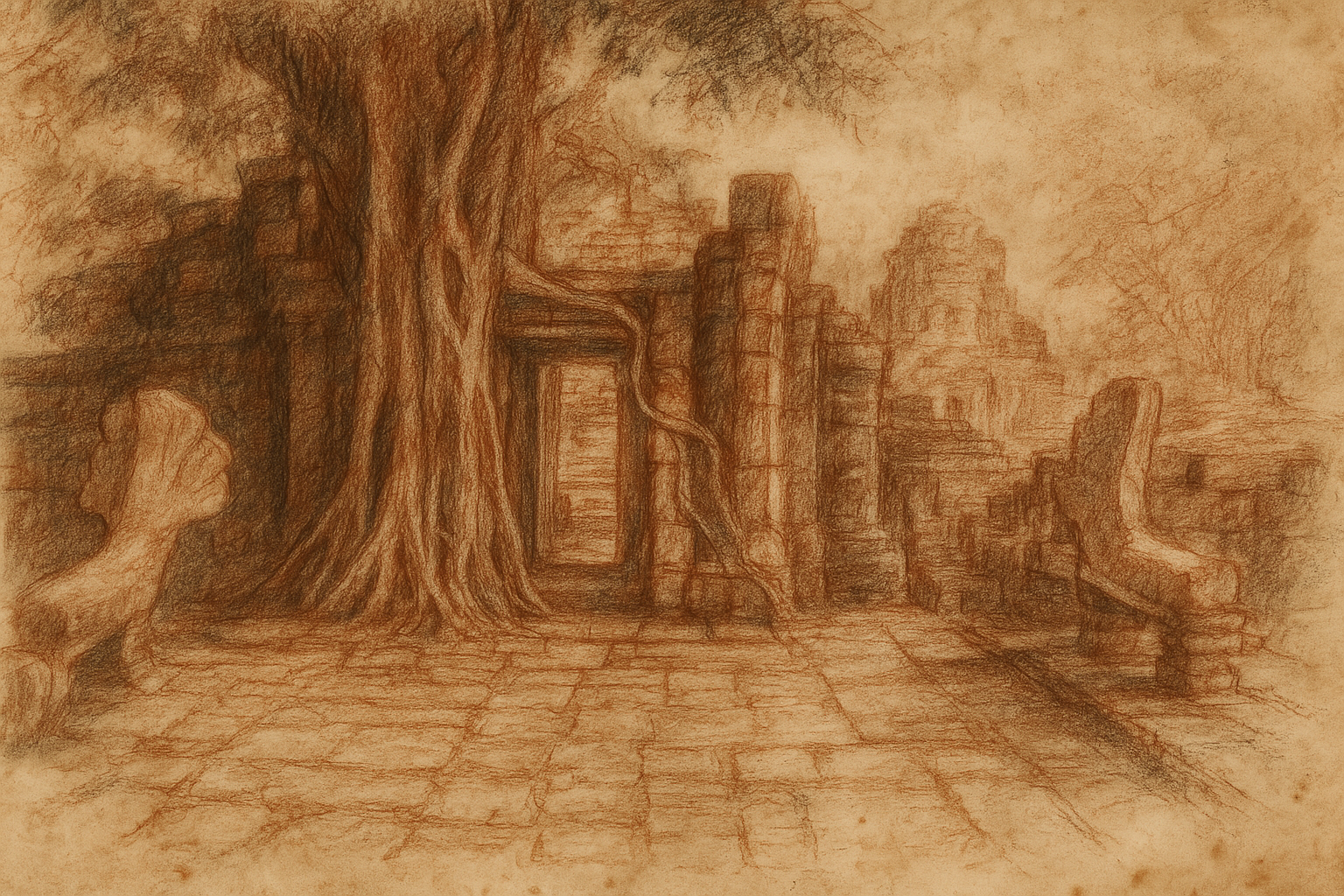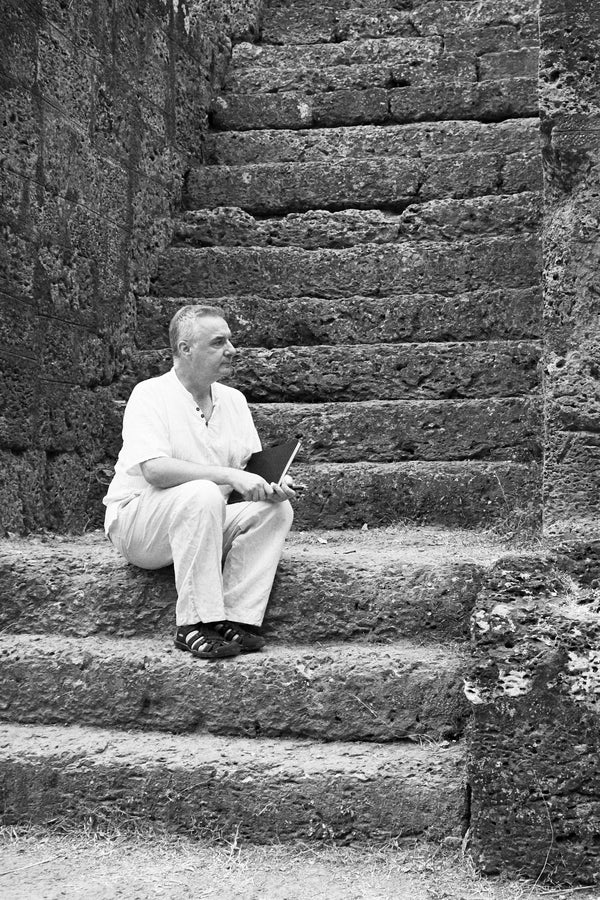Complimentary worldwide shipping on orders over $400 · No import tariffs for most countries
Complimentary worldwide shipping on orders over $400 · No import tariffs for most countries

Beneath the Wings of Silence
Preah Pitu · Forest Group — July 2025
Before the gods departed, they whispered into stone—
not to be heard, but felt in the breath between leaves.
The rain passed before dawn. The air still held its hush—a hush so complete that even our footsteps along the forest floor seemed borrowed. Annie and I left our motorcycle at the path’s edge and stepped into a deeper quiet, where the world had not yet stirred and the temples slept beneath their cloaks of shadow.
No one was there. No guides. No voices. Not even the hush of wind. Only the trees, solemn and watchful, received us beneath their dripping arms.
Kor Sak rose like an old friend—weatherworn, waiting, half-remembered. The temple’s western face emerged first, softened by a veil of mist. We crossed the cruciform terrace, where the slender naga balustrades still curled outward like gentle breaths at the edge of memory. The columns below the platform had the grace of something once airborne—like wings folded into stone.

Kor Sak’s western gate, gently held by the roots of a strangler fig.
We entered from the west. The small portico was wrapped in the roots of a strangler fig, knotted and silent, as if folded in prayer. The sanctuary’s tower had long since fallen, but the base remained—steep, pyramidal, ascending like a mountain of devotion. Scattered around its edges lay fragments: devata faces worn smooth by time, the curled paw of a lion, a lotus whose petals had folded inward into stone.
At the foot of the western porch, a great lintel whispered an older myth. Vishnu, serene and mustachioed, presided over the Churning of the Ocean. His gaze was closed in trust—as if he, too, knew that the world, though turned and turned again, would unfold as it must.
We stood there in stillness as the first light sifted softly through the trees.
The stones remember
what we forget—how to kneel
before morning light.
Leaving Kor Sak’s eastern gate, we walked beneath trees so tall they vanished into grey canopy. The path had narrowed to a trail, more breath than direction—moss and lichen dissolving softly beneath our feet. To either side, the forest guarded its secrets: broken lintels, fallen shrines, the outlines of altars turned to shadow. Gibbons called from high above, their voices lifting like questions that never needed answers. Wings fluttered unseen.
And then, as the clouds parted and the sky grew lighter, Ta Tuot revealed itself—not gradually, but with quiet authority, as though it had been watching all along. It rose upon a wide square platform—solemn, grounded, still. Though smaller than the great shrines of Angkor Wat, it held the weight of a mountain and the hush of a forest cell.
Inside the enclosure, beauty lay in fragments. Halves of Buddhas, faces of nagas, broken pediments, the hands of saints held in unseen mudras. The ground was still wet, and where light touched the moss, it glowed with a breathlike green.
We climbed slowly, barefoot, step by reverent step. Each stone carried memory. Each step an offering. The silence did not close—it opened. Within the sanctuary, carvings emerged from the dimness: Buddhas seated above doorways, weathered but radiant. Their expressions were not of peace alone, but of endurance—of grace that had endured the fall of empires.

Buddhas seated above the threshold, watching through centuries of light and shadow.

A luminous Buddha above the doorway, eyes closed beneath centuries of rain.
A lintel bearing three Buddhas remained nearly whole—each flanked by worshippers, their halos like soft flames etched in stone. We entered the central cella and looked up. Carved above the doors were thirty-seven seated Buddhas, each no taller than a kneeling prayer, as if placed for the one who would one day pause and look upward with open eyes.
We knelt. Annie lit incense. We spoke no words. We prayed for friends known and unknown, for those who grieve, for those who forget, for those becoming stone. The smoke curled slowly into the chamber like the breath of a lotus—unhurried, present.
I opened my notebook and sketched. The light was soft, reverent. I let my chalk trace the lines time had worn smooth. And in their weathering, they had become more real—less image, more presence.
Outside, as we descended, a shadow passed above us. Then another. We turned upward just as a pair of Great Hornbills swept overhead—wings wide, curving like myth. They circled slowly, then landed in the high branches. Their beaks gleamed like pale crescents, their calls deep and hollow, echoing down the trunks.
They stayed long enough to be seen.

Great Hornbills above Ta Tuot—curved beaks entwined in light, as though the forest dreamed them into being.
To the Khmer, these birds are not merely birds. They are omens—guardians of the threshold. They mate for life. In their bond lives the teaching of fidelity, of union that endures beyond a single season. To witness them here, above this forgotten shrine, was to feel the forest pause and look back.
Not everything forgotten is lost.
Some things wait in silence
until your silence matches theirs.
Then they rise—slowly,
as birds do,
as gods do,
not to be worshipped,
but remembered.
We followed the path farther east. Past newer stones. Past memories not yet weathered. At the edge of a small pond—full now from the rains—we found two stone elephants. They faced the water, unmoving, as if awaiting a reflection that had not yet come. The pond held the sky like a mirror unbroken.
All morning I had been thinking not just of temples, but of time—how it turns and folds, how it allows us to arrive not once, but again and again, if we are quiet enough to receive it.
The seated Buddhas remain.
The birds return.
And beneath the wings of silence, something ancient still breathes.
—
The gods may have gone, but they left the silence open.
Within the Gates of Angkor Thom
Photographs from the Spirit of Angkor series by Lucas Varro
Encircled by moats and laterite walls, Angkor Thom is not merely a city of stone—it is a sanctuary of vision, where kings once dreamed with the gods and silence still keeps its throne. Here, the great face towers of Bayon gaze outward with the serenity of watchful Buddhas, while tree roots curl like incense smoke over forgotten doorways, and light finds its way through broken lintels and lichen-covered prayer halls.
Each photograph in this collection was made by Lucas Varro within the sacred bounds of Angkor Thom, using medium and large format black-and-white film, often in the hours just before dawn. Shaped through long exposure, chiaroscuro, and careful hand-toning, these images are not records of architecture—they are offerings. Meditations in silver and ash. Echoes of stillness carved into the breath of light.
Presented as limited edition, hand-toned archival pigment prints on Hahnemühle Bamboo paper, each work arrives with a Collector’s Print Package including poetic writings, curatorial reflections, and field notes drawn from the artist’s daily pilgrimages through this ancient walled city.
This collection invites you into the heart of Angkor Thom—not as a visitor, but as a quiet witness.
Join My Studio Journal
Receive occasional letters from my studio in Siem Reap—offering a glimpse into my creative process, early access to new fine art prints, field notes from the temples of Angkor, exhibition announcements, and reflections on beauty, impermanence, and the spirit of place.
No noise. No clutter. Just quiet inspiration, delivered gently.
Subscribe and stay connected to the unfolding story.

Join My Studio Journal
Receive occasional letters from my studio in Siem Reap—offering a glimpse into my creative process, early access to new fine art prints, field notes from the temples of Angkor, exhibition announcements, and reflections on beauty, impermanence, and the spirit of place.
No noise. No clutter. Just quiet inspiration, delivered gently.
Subscribe and stay connected to the unfolding story.









